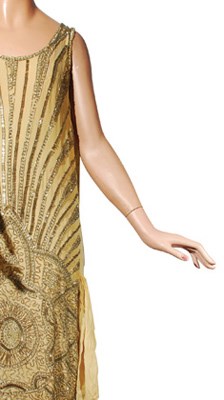TEN days ago: Fashion historian Ivan Sayers is narrating an offthe-cuff tour of the unfinished Museum of Vancouver exhibit Art Deco Chic: Extravagant Glamour Between the Wars.
The lights are turned low. The fabric of many of these vintage dresses from the 1920s and '30s is like gossamer, and bright lights can be damaging. Mannequins - a few of them from the same era - loiter about the gallery in various stages of dress. A handful are clustered as if watching horse races, others step out like they're headed to a party. The details are dizzying: the glitter of hand-beading, the swoop of a blush gown made from a single piece of fabric, velvet coats in prints that exactly match the chiffon dresses beneath them.
As he identifies designers (Lanvin, Vionnet, Patou, Schiaparelli), fabrics and cuts, Sayers suddenly stops talking and heads for the enclosed glass case containing one of the exhibit's most important pieces: a black Chanel dress featured in both British and German Vogue in 1928. The mannequin wearing it is just as old, her advanced years given away by her glass eyes and rooted hair. Still, she looks undeniably stylish in the beautifully cut dress, fox wrap (with head still attached, of course) and charming cloche.
"Sorry. I thought her gloves were just resting on top of her hand, but it's OK, she's holding them."
It's this attention to detail paid by Sayers and his co-curator Claus Jahnke that turns the exhibit into so much more than a massive, albeit very glam, closet. The 75 or so garments are all in the design style known as art deco, which took off in Paris in the 1920s and soon gained worldwide popularity. Its evolution is evident as the exhibit moves from '20s day wear - all boxy shapes and dropped waists - through to '30s evening wear, featuring a bevy of gorgeous, bias-cut, floorlength gowns.
It's about more than clothes, explains Sayers. The fashion speaks volumes about the era, from the prosperity and dynamism of the Roaring '20s, to the more practical and feminine styles worn in the '30s. Other influences came into play: geometric shapes evoke elegance and modernity, and thanks to an increase in global travel, inspiration also came from far-flung destinations.
Notable Vancouver items include a black beaded gown worn to the opening of the Commodore Cabaret in 1929 and a red and gold lamé evening dress made from fabric depicting the battles of the Trojan War.
The garments and accessories come from Sayers' and Jahnke's private collections, as well as from the MOV and other private collections.
Art Deco Chic: Extravagant Glamour Between the Wars opened yesterday. It runs to Sept. 23. Among the events planned as part of the exhibit, the curator's talk and tours are not to be missed, say Jahnke and Sayers.
"That's where you'll hear all the gossip behind the clothes. Everyone wants to hear the gossip," says Sayers.
Find out more at museumofvancouver.ca.



